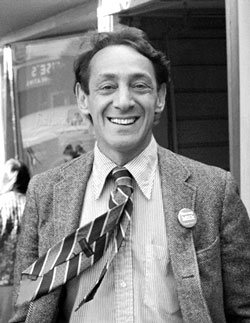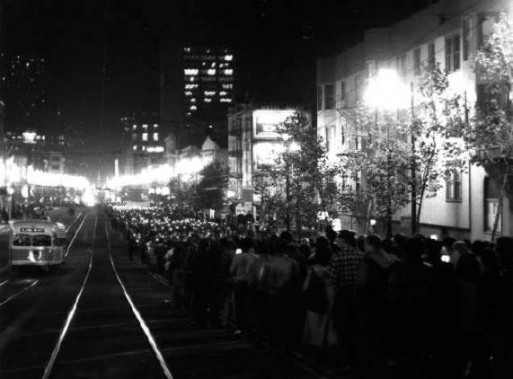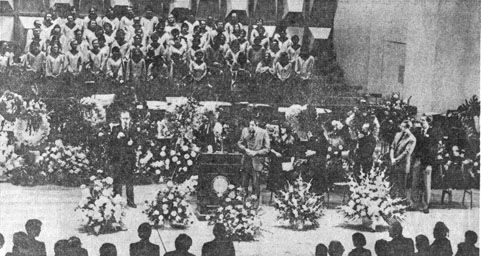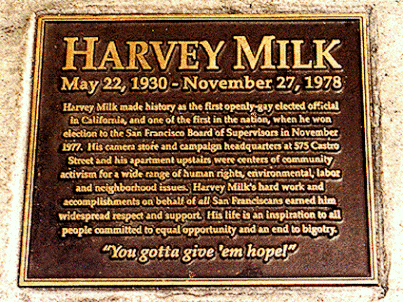The day was November 27th, 1978. After finding the two men herself, The president of the San Francisco Board of Supervisors, Dianne Feinstein, announced to the press, “Today San Francisco has experienced a double tragedy of immense proportions. As President of the Board of Supervisors, it is my duty to inform you that both Mayor Moscone and Supervisor Harvey Milk have been shot and killed.”
This was an unbearable blow to the gay community, from whose support Milk arose when he became the first openly gay man appointed to public office in California. Today, in celebration of Harvey Milk Day, I want to share the story of how his community remembered and memorialized the brave visionary many consider him to be.
That same evening, the streets of San Francisco overflowed with thousands of candles. People from all over San Francisco gathered spontaneously at Castro St. and Market to honor Harvey Milk’s life with a candlelight vigil. The crowd was Estimated to be between 25,000 and 40,000 people and it was led by a single drum. The procession extended over mile and a half from the Castro, the famous neighborhood where gay community rooted itself, to city hall. There, they placed their candles around the statue of Abraham Lincoln, creating a sea of flickering lights. With only a few sobs and whispers to break the silence, the vigil was remarkably quiet, and the wind calm enough to keep the candles lit. Then, through a megaphone, folk singer Joan Baez sang “Amazing Grace”. It must have been spectacular to witness.
The next day abounded with memorial services. The first, held at city hall, was opened to the public. 10,000 people walked through to view the caskets of the mayor and supervisor, laying over 400 wreathes and innumerable tears. There were so many people, in fact, that the viewing was extended for an additional hour. From there, Milk’s remains were given another memorial service at Temple Manuel, and another, private funeral mass the following Thursday morning. Finally, that evening, another public service was held at the Opera house. 4,000 people filled the audience, and another 1,000 gathered outside and listened. For such a public man, what could have been more fitting than to have four services in two days? I find it remarkable how the services were hosted in all realms of public life, from government, to religious and to cultural memorials. Such thorough response shows he extent to which Milk was received as a martyr for the gay liberation movement.
The rest of Milk’s processions and memorials become more peaceful and intimate. Most of his cremated remains were scattered by his closest friends in the San Francisco Bay. Some of them were buried beneath the sidewalk in front of his home and former business, Castro Camera at 575 Castro Street, which he shared with his longtime partner, Scott Smith. The memorial plaque can still be seen today.
So today, as you consider how far we’ve come in gay liberation—and how far we’ve yet to go—remember how much of it was made possible by people like Harvey Milk. Maybe you’ll just put on the movie Milk and watch Sean Penn kiss James Franco, which is fine too. But first, here is a poem written by Milk, found in his papers by lesbian activist Anne Kronenberg and read aloud at the Opera House memorial:
I can be killed with ease.
I can be cut right down.
But I cannot fall back into my closet.
I have grown.
I am not myself.
I am too many.
I am all of us.
More LGBT-related posts from SevenPonds:
- Man of Many Faces
- Memorial Music: “The Show Must Go On” by Queen
- A Shrine for the Lost in The Man with Night Sweats

 The Splendid Memorials of Harvey Milk
The Splendid Memorials of Harvey Milk







 Meaning-Focused Grief Therapy: Imaginal Dialogues with the Deceased
Meaning-Focused Grief Therapy: Imaginal Dialogues with the Deceased
 Flawed Kidney Function Test Discriminated Against Black Patients
Flawed Kidney Function Test Discriminated Against Black Patients














